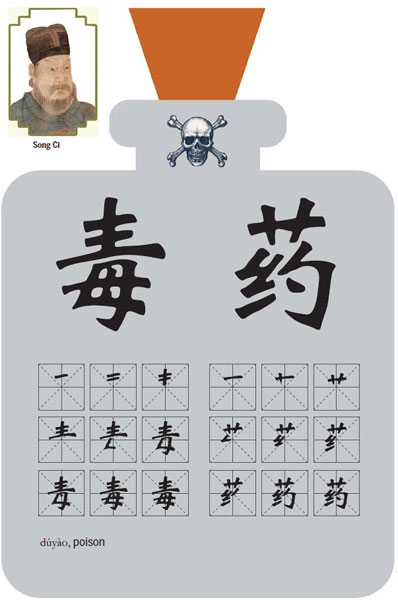Pick your poison
Updated: 2014-10-03 12:21
By Zhu Weijing(China Daily)
|
||||||||
 |
|
[Photo provided to China Daily] |
Toxins have been used in China for millennia, some with such chilling names as 'intestine-rupturing herb' and 'three-laugh death powder'. Zhu Weijing reports.
If you want someone dead but don't want to get caught, poison is the way to go. Or, maybe you just want someone to die painfully and slowly. Again, poison is the way to go. The world recently watched King Joffrey Baratheon's death from a poison known as The Strangler on HBO's Game of Thrones. China has long had its own legendary poisons to dish out. A chapter on poisoning in the Song Dynasty (960-1279) book Instructions to Coroners by Song Ci, the founding father of forensic science in China, begins: "For those who die of poisoning, their orifices open, their face turns greenish black or green, their lips go purplish green, their nails appear dark green, and blood spews out of their mouth, eyes, ears, and nose." A grim fate indeed.
The ancient Chinese excelled in the discovery, use and cure of poisons - some familiar to us today and some with chilling names, including lethal poisons such as arsenic, "intestine-rupturing herb", "crane's red crown" and "three-laugh death powder".
Arsenic, the king of poisons, is perhaps one of the few toxins that transcend time, national borders and social class. A favorite of the Romans and Europeans in the Middle Ages, arsenic was a classic in ancient China as well. It was the poison of choice when the famously wanton Pan Jinlian and her lover decided to murder her husband in the classic 14th century Chinese novel Outlaws of the Marsh.
It also brought death to China's penultimate emperor Guangxu, although the cause of death was not confirmed until 2008, 100 years after the emperor's face turned blue at the age of 37. To this day, the murderer of Guangxu remains somewhat of a mystery, given that arsenic is colorless, odorless, tasteless and difficult to detect.
Throughout Chinese history, as often depicted on TV shows, the Chinese believed in a not-so-foolproof method to test for poisoning that involved the poking of a silver needle into food, drinks or bodies.
As Song Ci instructs: "To confirm that poisoning has taken place, a silver needle that has been scrubbed in soapy water should be stuck into the victim's mouth. If the needle turns a blackish color that cannot be washed off, then poisoning can be confirmed."
However, modern science tells a different story. It appears that the only reason the silver needle worked occasionally with arsenic was the crude methods used to make arsenic: Sulfide that commonly existed alongside arsenic in nature can turn silver black.
Aside from minerals, plants were readily available as alternatives. Given the Chinese obsession with and knowledge of herbal medicine, the appropriation of herbs as weapons is easy to understand.
Shennong - a legendary ruler of predynastic China from the beginning of the third millennium BC, the discoverer of different qualities of herbs and the father of Chinese medicine - died of a toxic herb.
In some surprising cases, poison can cure as well as kill. One of the best-known examples of "counteracting one poison with another" is perhaps an incident in the martial arts novel The Legend of Condor Heroes by Jin Yong, in which the protagonist, poisoned by datura, which is also known as angel's trumpet, was saved by taking a mythically horrifying and lethal "intestine-rupturing herb".
Among the many bloodcurdling varieties in the "intestine-rupturing" family, one of the most toxic is hemlock. In the beginning, the victim feels a burning in the throat, followed by vomiting and excruciating pain in the abdomen. Eventually, victims of this poison die of respiratory failure.
Jianxue Fenghou, literally "meets blood and seals throat", is another infamous poison and comes from the upas or poison arrow tree. Once often used on arrowheads, when the poison contacts an open wound or blood, it brings nearly instant death. It is found in Yunnan and Hainan provinces. Locals in Yunnan describe its effect as "whoever's infected with the poison can only take seven steps forward or eight steps back before death".
However, poison isn't just for traitors and schemers. It was also used as a "gift death", used in euthanasia or to protect the honor of the soon-to-be deceased. One famous example is "China's Nostradamus", the military commander and prognosticator Liu Bowen, who was rumored to have been given a cup of poison wine from the founder of the Ming Dynasty (1368-1644).
Those deemed worthy of an honorable death and a gift from the emperor, such as a doomed high-ranking official or concubine, would be offered either the rope with which to hang themselves, the dagger with which to stab themselves, or a nice cup of poisonous wine. As the Chinese saying goes: "If his majesty wants my death, I have to die." The toxic contents of the imperial poisonous wine were usually, according to legend, the "crane's red crown", poison-feather bird zhen, or arsenic.
Many believe that "crane's red crown" was merely a euphemism for arsenic, whereas the mythical poison of the zhen is pretty obviously an invention of Chinese legend. Described in the Classic of Mountains and Seas, an ancient Chinese classic text and a compilation of early geography and myth, zhen was a purple and green bird the size of a falcon.
Often referenced in myths, poetry and literature, the word zhen later became synonymous with poison, as merely dipping the bird's feathers in any liquor guaranteed the drinker's death.
Other bewildering poisons result in a cacophony of incredible symptoms. The "three-laugh death powder", for instance, is rumored to be undetectable, and the victim dies after giving an eerie, sardonic grin three times. The legendary body-melting powder works much like sulfuric acid, melting the body and clothes. However, even if these fantastical murder potions existed, their recipes have long since disappeared.
The zhen bird may be mythical (or extinct), but arsenic, hemlock, and even Nerium oleander passed through history and into legendary fame, ensuring many a horrifying death.

 Chinese FM Wang Yi meets with Mexican president
Chinese FM Wang Yi meets with Mexican president
 China leads medal table as Asian Games close
China leads medal table as Asian Games close
 Highlights at Paris auto show
Highlights at Paris auto show
 Upcoming month for promoting Chinese films in Hollywood
Upcoming month for promoting Chinese films in Hollywood
 Traffic jam turns tunnel into a dog-walking lot
Traffic jam turns tunnel into a dog-walking lot
 HK urges end to 'Occupy' protests
HK urges end to 'Occupy' protests
 Young Chinese footballers learn from the best in Brazil
Young Chinese footballers learn from the best in Brazil
 Autumn fairy tales in China
Autumn fairy tales in China
Most Viewed
Editor's Picks

|

|

|

|

|

|
Today's Top News
19 arrested over clash in Hong Kong
Li's European tour aims pragmatic cooperation
Services growth hits 8-month low
Firmly safeguard rule of law in HK
Hong Kong chief calls for peace after clashes
Two Koreas to hold second round
of talks
Overseas experts laud Xi's remarks
US visas hinder talent search: expert
US Weekly

|

|







